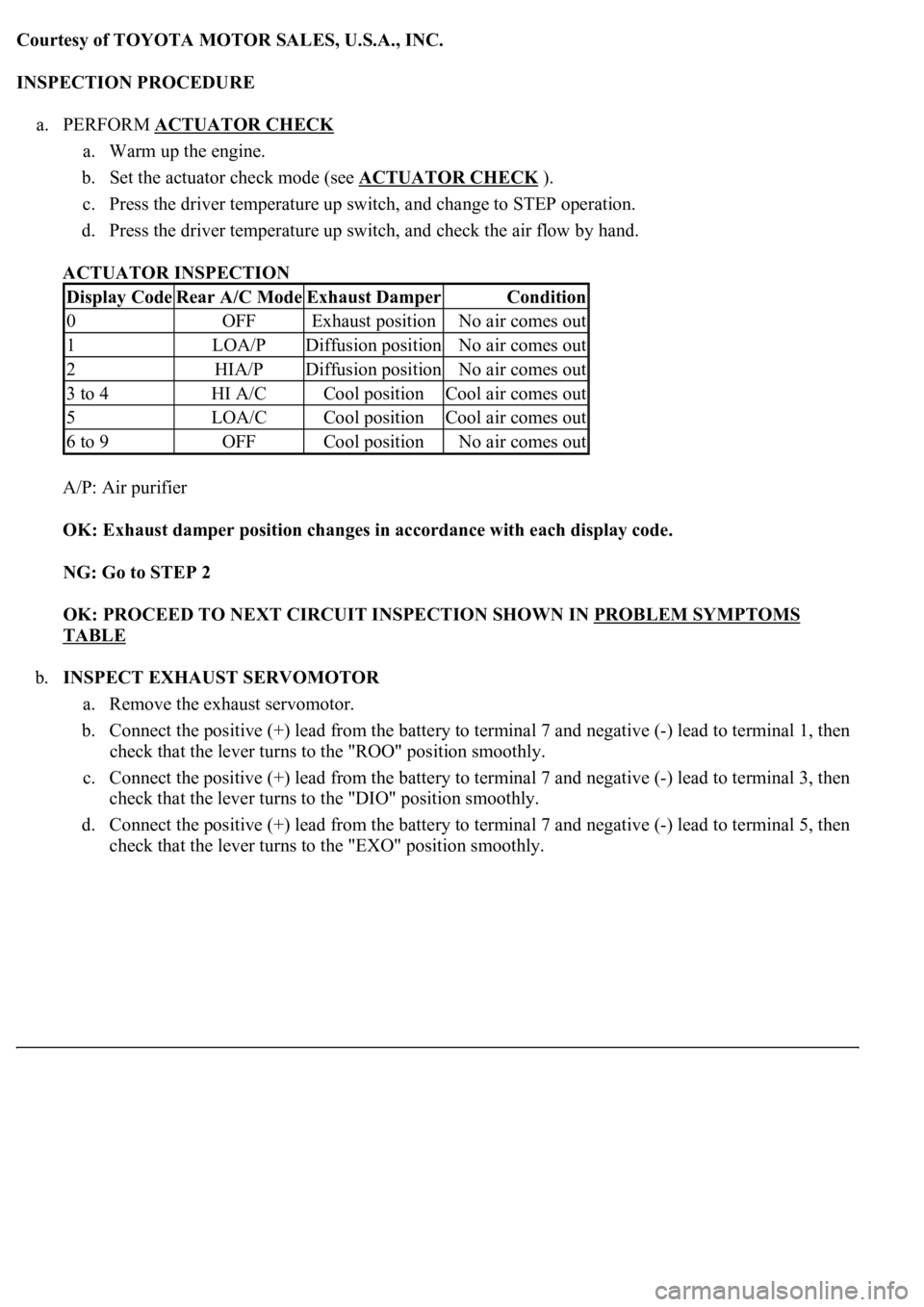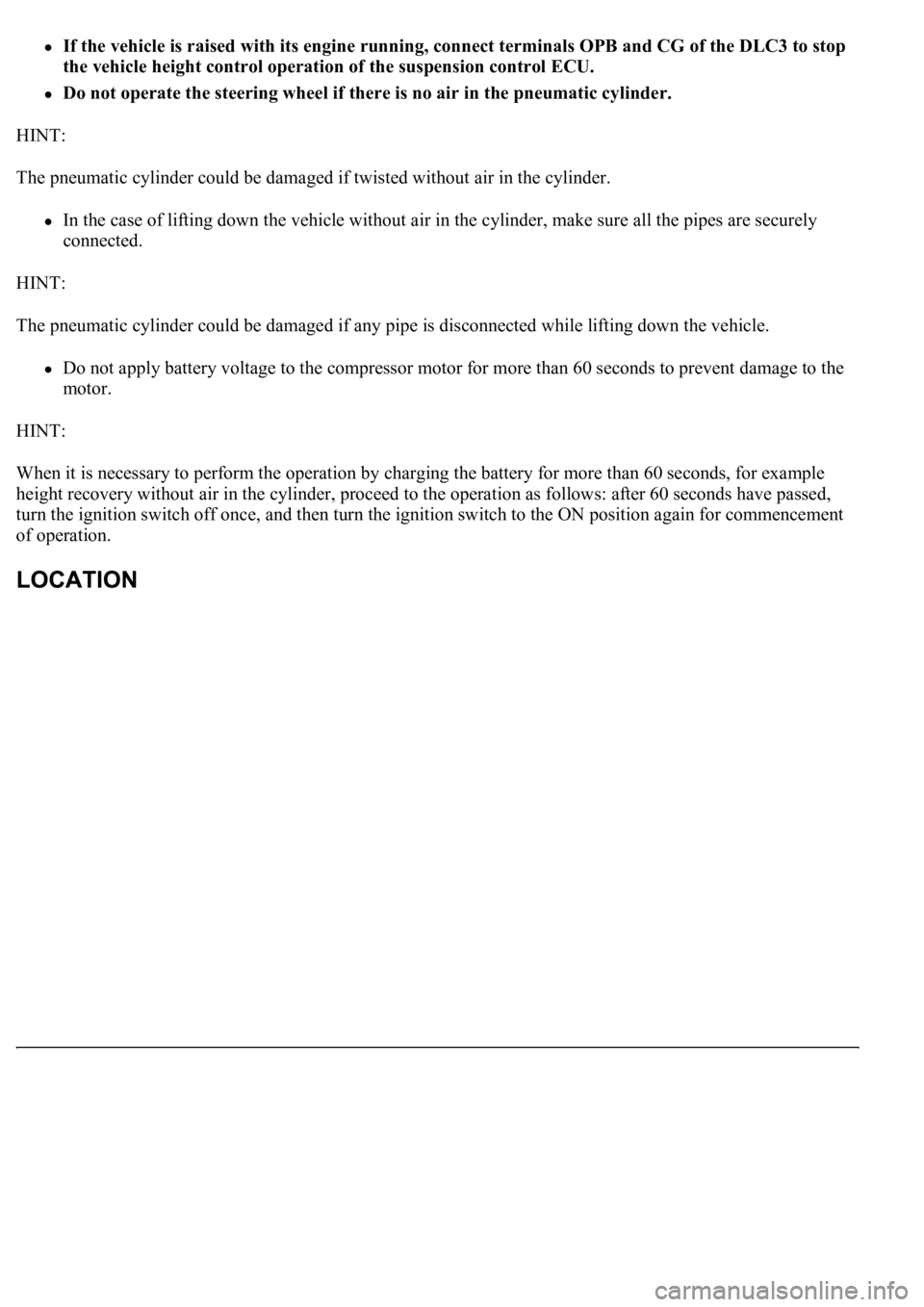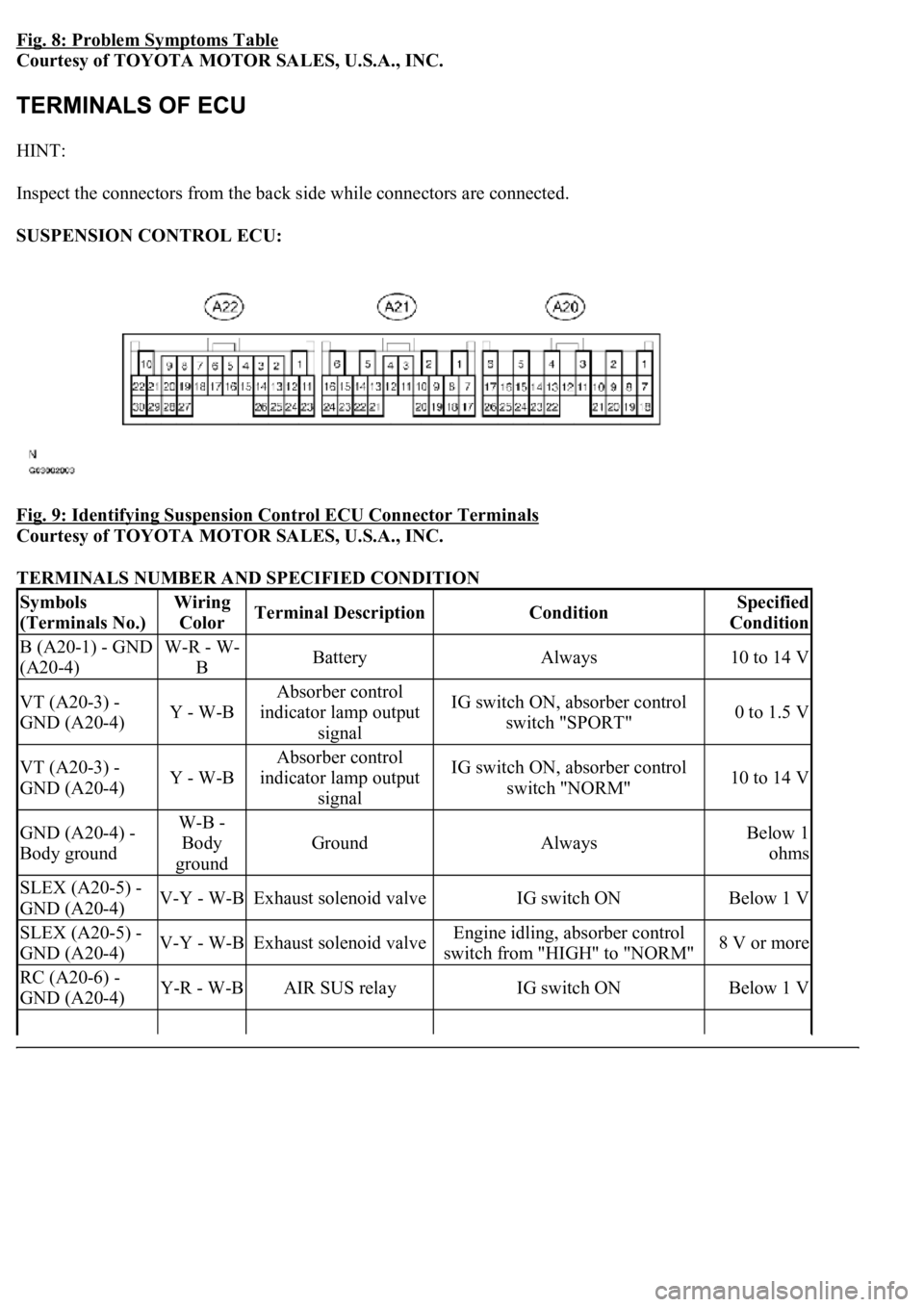2003 LEXUS LS430 engine
[x] Cancel search: enginePage 444 of 4500

Courtesy of TOYOTA MOTOR SALES, U.S.A., INC.
INSPECTION PROCEDURE
a. PERFORM ACTUATOR CHECK
a. Warm up the engine.
b. Set the actuator check mode (see ACTUATOR CHECK
).
c. Press the driver temperature up switch, and change to STEP operation.
d. Press the driver temperature up switch, and check the air flow by hand.
ACTUATOR INSPECTION
A/P: Air purifier
OK: Exhaust damper position changes in accordance with each display code.
NG: Go to STEP 2
OK: PROCEED TO NEXT CIRCUIT INSPECTION SHOWN IN PROBLEM SYMPTOMS
TABLE
b.INSPECT EXHAUST SERVOMOTOR
a. Remove the exhaust servomotor.
b. Connect the positive (+) lead from the battery to terminal 7 and negative (-) lead to terminal 1, then
check that the lever turns to the "ROO" position smoothly.
c. Connect the positive (+) lead from the battery to terminal 7 and negative (-) lead to terminal 3, then
check that the lever turns to the "DIO" position smoothly.
d. Connect the positive (+) lead from the battery to terminal 7 and negative (-) lead to terminal 5, then
check that the lever turns to the "EXO" position smoothl
y.
Display CodeRear A/C ModeExhaust DamperCondition
0OFFExhaust positionNo air comes out
1LOA/PDiffusion positionNo air comes out
2HIA/PDiffusion positionNo air comes out
3 to 4HI A/CCool positionCool air comes out
5LOA/CCool positionCool air comes out
6 to 9OFFCool positionNo air comes out
Page 469 of 4500

If the vehicle is raised with its engine running, connect terminals OPB and CG of the DLC3 to stop
the vehicle height control operation of the suspension control ECU.
Do not operate the steering wheel if there is no air in the pneumatic cylinder.
HINT:
The pneumatic cylinder could be damaged if twisted without air in the cylinder.
In the case of lifting down the vehicle without air in the cylinder, make sure all the pipes are securely
connected.
HINT:
The pneumatic cylinder could be damaged if any pipe is disconnected while lifting down the vehicle.
Do not apply battery voltage to the compressor motor for more than 60 seconds to prevent damage to the
motor.
HINT:
When it is necessary to perform the operation by charging the battery for more than 60 seconds, for example
height recovery without air in the cylinder, proceed to the operation as follows: after 60 seconds have passed,
turn the ignition switch off once, and then turn the ignition switch to the ON position again for commencement
of operation.
Page 472 of 4500

a. The suspension control ECU operates the compressor & motor with the dryer and uses the solenoid
valves to control the vehicle height by analyzing the information based on the switches, sensors and
input signals.
b. Through the 4 height control sensors, the suspension control ECU detects the changes in the vehicle
height that results from the number of occupants or the amount of the load. Then, the suspension
control ECU controls the height control solenoid valves and the compressor & motor with the dryer
in order to automatically adjust the vehicle height to a constant (normal) level.
c. Furthermore, two vehicle heights can be selected by operating the height control switch: HI and
Normal.
d. In cases such as when the vehicle is jacked up, the auto leveling function is prohibited by turning
the ignition switch off.
If the vehicle is raised with its engine running, connect terminals OPB and CG of the DLC3 so the
vehicle height control is not carried out.
e. The absorber control switch selects the shock absorber damping force (normal or sport).
f. w/ Pre-collision safety system:
The suspension control ECU changes the stiffness of the suspension to the hardest setting by
receiving signals (collision unavoidable) from the cruise control ECU.
Function of Components
Page 480 of 4500

Fig. 8: Problem Symptoms Table
Courtesy of TOYOTA MOTOR SALES, U.S.A., INC.
HINT:
Inspect the connectors from the back side while connectors are connected.
SUSPENSION CONTROL ECU:
Fig. 9: Identifying Suspension Control ECU Connector Terminals
Courtesy of TOYOTA MOTOR SALES, U.S.A., INC.
TERMINALS NUMBER AND SPECIFIED CONDITION
Symbols
(Terminals No.)Wiring
ColorTerminal DescriptionConditionSpecified
Condition
B (A20-1) - GND
(A20-4)W-R - W-
BBatteryAlways10 to 14 V
VT (A20-3) -
GND (A20-4)Y - W-B
Absorber control
indicator lamp output
signalIG switch ON, absorber control
switch "SPORT"0 to 1.5 V
VT (A20-3) -
GND (A20-4)Y - W-B
Absorber control
indicator lamp output
signalIG switch ON, absorber control
switch "NORM"10 to 14 V
GND (A20-4) -
Body groundW-B -
Body
ground
GroundAlwaysBelow 1
ohms
SLEX (A20-5) -
GND (A20-4)V-Y - W-BExhaust solenoid valveIG switch ONBelow 1 V
SLEX (A20-5) -
GND (A20-4)V-Y - W-BExhaust solenoid valveEngine idling, absorber control
switch from "HIGH" to "NORM"8 V or more
RC (A20-6) -
GND (A20-4)Y-R - W-BAIR SUS relayIG switch ONBelow 1 V
Page 481 of 4500

RC (A20-6) -
GND (A20-4)Y-R - W-BAIR SUS relay
Engine idling, height control switch
from "NORM" to "HIGH" during
compressor operation
8 V or more
CANH (A20-7) -
CANL (A20-8)BR - YCAN communication
lineIG switch OFF54 to 67
ohms
SW1 (A20-9) -
GND (A20-4)O - W-BAbsorber control switch
input signalEngine idling, absorber control
switch "NORM" position10 to 14 V
SW1 (A20-9) -
GND (A20-4)O - W-BAbsorber control switch
input signalEngine idling, absorber control
switch "SPORT" position0 to 1.5 V
SIL (A20-13) -
GND (A20-4)W-G - W-
BDiagnosis tester
communication lineIG switch ONPulse
generation
TD (A20-14) -
GND (A20-4)L-B - W-BHeight control is not
operatingIG switch ON10 to 14 V
HSW (A20-15) -
GND (A20-4)LG-B - W-
BHeight control switch
input signalIG switch ON, height control
switch "NORM" position10 to 14 V
HSW (A20-15) -
GND (A20-4)LG-B - W-
BHeight control switch
input signalIG switch ON, height control
switch "HIGH" position0 to 1.5 V
SLFR (A20-16) -
GND (A20-4)G-W - W-
BHeight control solenoid
valve (FR)IG switch ONBelow 1 V
SLFR (A20-16) -
GND (A20-4)G-W - W-
BHeight control solenoid
valve (FR)Engine idling, height control switch
from "NORM" to "HIGH" or
reverse
8 V or more
SLFL (A20-17) -
GND (A20-4)R-W - W-
BHeight control solenoid
valve (FL)IG switch ONBelow 1 V
SLFL (A20-17) -
GND (A20-4)R-W - W-
BHeight control solenoid
valve (FL)Engine idling, height control switch
from "NORM" to "HIGH" or
reverse
8 V or more
SBL1 (A20-18) -
GND (A20-4)LG-R - W-
BHeight control sensor
power source (FL)IG switch ON4.5 to 5.5 V
VH (A20-19) -
GND (A20-4)P - W-BHeight control indicator
output signalIG switch ON, height control
switch "HIGH"0 to 1.5 V
SBR1 (A20-20) -
GND (A20-4)V-R - W-BHeight control indicator
output signalIG switch ON, height control
switch "NORM"10 to 14 V
SBR1 (A20-20) -
GND (A20-4)V-R - W-BHeight control sensor
power source (FR)IG switch ON4.5 to 5.5 V
SGR1 (A20-21) -
GND (A20-4)R-L - W-BHeight control sensor
ground (FR)AlwaysBelow 1
ohms
SGL1 (A20-22) -
GND (A20-4)LG-B - W-
BHeight control sensor
ground (FL)AlwaysBelow 1
ohms
FAR+ (A21-1) -
FAR- (A21-2)O - R-YSuspension control
actuator (FR)IG switch ONBelow 1
ohms
FBR+ (A21-3) -
FBR- (A21-4)R-G - L-GSuspension control
actuator (FR)IG switch ONBelow 1
ohms
FAL+ (A21-5) -
FAL- (A21-14)G-B - G-RSuspension control
actuator (FL)IG switch ONBelow 1
ohms
Page 482 of 4500

FBL+ (A21-6) -
FBL- (A21-16)G-W - G-
OSuspension control
actuator (FL)IG switch ONBelow 1
ohms
SLRL (A21-7) -
GND (A20-4)P-L - W-BHeight control solenoid
valve (RL)IG switch ONBelow 1 V
SLRL (A21-7) -
GND (A20-4)P-L - W-BHeight control solenoid
valve (RL)Engine idling, height control switch
from "NORM" to "HIGH" or
reverse
8 V or more
SLRR (A21-8) -
GND (A20-4)P - W-BHeight control solenoid
valve (RR)IG switch ONBelow 1 V
SLRR (A21-8) -
GND (A20-4)P - W-BHeight control solenoid
valve (RR)Engine idling, height control switch
from "NORM" to "HIGH" or
reverse
8 V or more
RM+ (A21-17) -
GND (A20-4)BR-Y - W-
BMotor lock (+)
Engine idling, height control switch
from "NORM" to "HIGH" during
compressor operation
Below 1 V
RM- (A21-18) -
GND (A20-4)BR-B - W-
BMotor lock (-)AlwaysBelow 1
ohms
SHR2 (A21-19) -
GND (A20-4)W - W-BHeight control sensor
(HID rear)IG switch ON0.5 to 4.5 V
SHFR (A21-20) -
GND (A20-4)B-W - W-
BHeight control sensor
(FR)IG switch ON0.5 to 4.5 V
SHFR (A21-20) -
GND (A20-4)B-W - W-
BHeight control sensor
(FR)Engine idling, height control switch
"NORM"Approx. 2.5
V
SHF2 (A21-21) -
GND (A20-4)V-G - W-BHeight control sensor
(HID front)IG switch ON0.5 to 4.5 V
SHFL (A21-22) -
GND (A20-4)L - W-BHeight control sensor
(FL)IG switch ON0.5 to 4.5 V
SHFL (A21-22) -
GND (A20-4)L - W-BHeight control sensor
(FL)Engine idling, height control switch
"NORM"Approx. 2.5
V
SBL3 (A21-23) -
GND (A20-4)B - W-BHeight control sensor
power source (HID)IG switch ON4.5 to 5.5 V
SGL3 (A21-24) -
GND (A20-4)V-Y - W-BHeight control sensor
ground (HID)AlwaysBelow 1
ohms
RAR+ (A22-2) -
RAR- (A22-3)Y - SBSuspension control
actuator (RR)IG switch ONBelow 1
ohms
RBR+ (A22-4) -
RBR- (A22-5)LG - PSuspension control
actuator (RR)IG switch ONBelow 1
ohms
RAL+ (A22-6) -
RAL- (A22-7)L - GSuspension control
actuator (RL)IG switch ONBelow 1
ohms
RBL+ (A22-8) -
RBL- (A22-9)O - BRSuspension control
actuator (RLIG switch ONBelow 1
ohms
SGR3 (A22-12) -
GND (A20-4)W - W-BAcceleration sensor
ground (rear)AlwaysBelow 1
ohms
SBR3 (A22-15) -
GND (A20-4)R - W-BAcceleration sensor
power source (rear)IG switch ON4.5 to 5.5 V
Page 483 of 4500

1.DIAGNOSIS SYSTEM
a. Inspect the battery voltage.
Battery voltage: 11 to 14 V
If the voltage is below 11 V, recharge the battery before proceeding.
b. Check DLC3.
The suspension control ECU uses the CAN system and ISO 9141-2 for communication. The
terminal arrangement of the DLC3 complies with SAE J1962 and matches the ISO 9141-2 format.
Verify the conditions listed in the table below:
SGL2 (A22-23) -
GND (A20-4)GR - W-BHeight control sensor
ground (RL)AlwaysBelow 1
ohms
SBL2 (A22-24) -
GND (A20-4)BR - W-BHeight control sensor
power source (RL)IG switch ON4.5 to 5.5 V
SGR2 (A22-25) -
GND (A20-4)V - W-BHeight control sensor
ground (RR)AlwaysBelow 1
ohms
SBR2 (A22-26) -
GND (A20-4)B - W-BHeight control sensor
power source (RR)IG switch ON4.5 to 5.5 V
SGRR (A22-27) -
GND (A20-4)L - W-BAcceleration sensor
(rear)IG switch ON, keep the vehicle still
without any vertical movement for
1 secondApprox. 2.5
V
SHRR (A22-28) -
GND (A20-4)P - W-BHeight control sensor
(RR)IG switch ON0.5 to 4.5 V
SHRR (A22-28) -
GND (A20-4)P - W-BHeight control sensor
(RR)Engine idling, height control switch
"NORM"Approx. 2.5
V
SGFL (A22-29) -
GND (A20-4)B - W-BAcceleration sensor
(front)IG switch ON, keep the vehicle still
without any vertical movement for
1 secondApprox. 2.5
V
SHRL (A22-30) -
GND (A20-4)LG - W-BHeight control sensor
(RL)IG switch ON0.5 to 4.5 V
SHRL (A22-30) -
GND (A20-4)LG - W-BHeight control sensor
(RL)Engine idling, height control switch
"NORM"Approx. 2.5
V
Page 495 of 4500

Fig. 17: Diagnostic Trouble Code Information Chart (2 Of 2)
Courtesy of TOYOTA MOTOR SALES, U.S.A., INC.
*1: For codes in the "Indicator Light" column with a "circ" mark, the absorber control indicator lamp blinks at 1
second intervals.
*2: For codes in the "Indicator Light" column with a " (xcirc)" mark, when trouble occurs, "HEIGHT HI" is
displayed on the multi-information display. Also, the master warning light is lit on the combination meter and
an alarm sounds.
*3: Since the relief pressure of the compressed air is 980 kPa (10 kgf/cm
2 , 142 psi), if vehicle height control is
attempted on a steeply sloping road, when the vehicle is overloaded, or when the vehicle height is jacked up
with the engine running, code "C1751" may be output and vehicle height control may be suspended. (This is not
abnormal.) In this case, however, when detecting the first error, approximately 10 minutes after the ignition
switch was turned to the ON position, vehicle height control is resumed. When the following errors are
detected, it takes 70 minutes until the control is resumed.
*4: If vehicle height control is operated while the wheels are removed or the vehicle is jacked up, code "C1752"
may be output, but this is not abnormal. When code "C1752" is output, vehicle height control is not carried out.
However, control is resumed if the ignition switch is turned off, then to the ON position again.
CIRCUIT DESCRIPTION
The height control sensor sub-assy controls the resistance value by following changes in vehicle height. The
suspension control ECU detects the change in vehicle height from the transformed voltage. The suspension
control ECU outputs a constant voltage of 5 V to the SHB terminal of the height control sensor sub-assy.
In the height control sensor, the voltage is changed due to resistance. The changed voltage is output from the